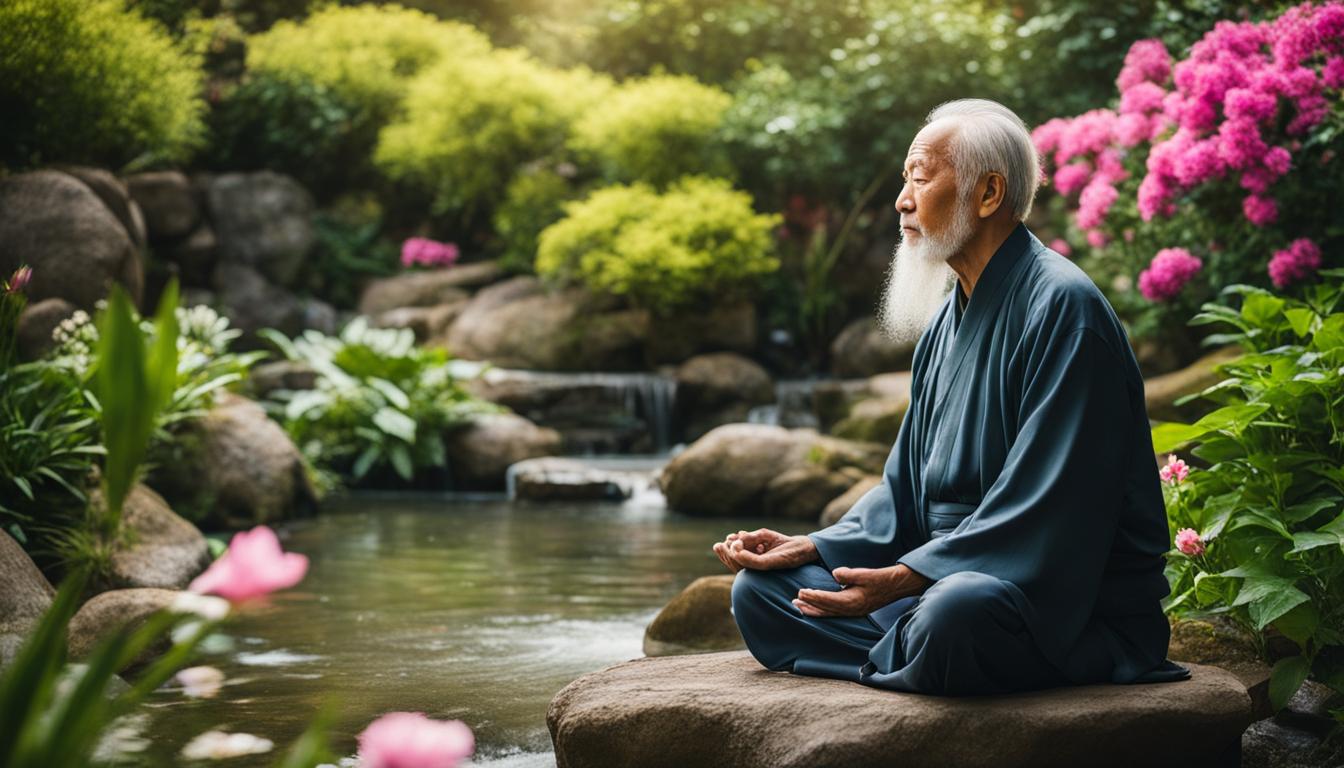Discover the serenity and tranquility that Chinese meditation techniques can bring to your life. One such practice, Qigong, combines flowing movement, breath regulation, and meditation to enhance the body’s natural energy flow and promote overall well-being.
Key Takeaways:
- Qigong is a traditional Chinese practice that integrates movement, breathing, and meditation.
- It offers numerous benefits, including stress reduction, improved mental clarity, and enhanced physical health.
- Qigong meditation techniques promote relaxation, emotional balance, and a deeper connection with one’s surroundings.
- Practicing Qigong meditation involves creating a serene space, focusing on breath, and maintaining consistency.
- Techniques like Breath Awareness Meditation and Body Scan Meditation can help deepen your meditation practice.
What is Qigong Meditation?
Qigong meditation is a practice rooted in ancient Chinese wisdom that combines meditation, controlled breathing, and gentle movement. It is often referred to as “energy cultivation” and aims to cultivate and balance the body’s life force energy, known as Qi.
Qigong meditation is believed to promote better mental, physical, and spiritual health by allowing the energy to flow freely through the body’s energy pathways. This practice is deeply ingrained in Chinese culture and has been passed down through generations as a means of exercise, relaxation, and healing.

Through Qigong meditation, individuals can tap into the inherent energy within their bodies and harness its power to promote overall well-being. By integrating meditation, breathing techniques, and gentle movements, Qigong meditation offers a holistic approach to self-care and inner harmony.
“Qigong meditation allows us to cultivate a deep connection with our Qi, fostering balance and a sense of tranquility.”
There are various types of Qigong meditation, each with its own unique benefits and techniques. Some forms of Qigong meditation are active, involving fluid movements and energy circulation, while others are passive, focusing on stillness and internal awareness. These practices can be practiced individually or combined to create a personalized Qigong meditation practice.
Qigong meditation provides a sanctuary for individuals to cultivate a peaceful mind, harmonious energy flow, and spiritual growth. It has been embraced by people around the world for its profound ability to promote better health, mental clarity, and emotional well-being.
Through Qigong meditation, individuals can embark on a journey of self-discovery, exploring the depth of their inner selves and connecting with the essence of life.
Benefits of Qigong Meditation Techniques
Qigong meditation techniques offer a wide range of holistic benefits. By incorporating mindfulness practices deeply rooted in Chinese culture, practitioners can experience enhanced relaxation, stress reduction, and emotional balance.
The balanced flow of energy, known as Qi, achieved through Qigong meditation promotes vitality and an overall sense of well-being. This ancient practice also strengthens the mind-body connection, fostering mindfulness and present-moment awareness.
Research suggests that regular Qigong meditation may have a positive impact on physical health as well. Studies have shown that it can lower the risk of chronic conditions such as type 2 diabetes and heart disease.
Practicing Qigong meditation offers a holistic approach to healing and self-care, allowing individuals to cultivate a deep sense of well-being and inner harmony. By integrating movement, breath regulation, and meditation, Qigong aligns the mind, body, and spirit, promoting a balanced and healthy lifestyle.

Qigong meditation techniques provide a path to self-transformation and profound well-being. By integrating ancient wisdom and mindfulness practices, individuals can achieve a harmonious and balanced life.
To fully embrace the benefits of Chinese meditation, it is important to explore and incorporate Qigong meditation techniques into your daily routine. Whether you are seeking relaxation, stress reduction, or a deeper connection with yourself and the world around you, Qigong meditation can guide you on your journey towards overall well-being.
How to Practice Qigong Meditation
Practicing Qigong meditation requires creating a serene space where you can be undisturbed. Whether you prefer sitting, standing, or lying down, find a posture that is comfortable for you. The key is to create a calm and peaceful environment that allows you to focus inward.

Once you’re in a comfortable position, begin by focusing on your breath. Allow your breath to flow naturally, paying attention to each inhale and exhale. This conscious awareness of the breath is a fundamental aspect of Qigong meditation.
Adopting the proper Qigong posture will help facilitate the energy flow throughout your body. Relax your muscles, straighten your spine, and maintain a gentle and grounded stance. Imagine a golden thread gently pulling the crown of your head upwards, aligning your posture and allowing the energy to flow freely.
Engage in deep, relaxed breathing. Inhale deeply, expanding your abdomen, and exhale slowly, releasing any tension or stress. With each breath, imagine your body becoming more relaxed and at ease.
Start with simple relaxation exercises, such as progressive muscle relaxation or body scans, to ease into the practice. These exercises help release tensions and promote a state of calm and relaxation.
As you become more comfortable with the practice, you can explore more complex Qigong meditation techniques. These techniques may involve specific movements, visualizations, or mantras. Embrace the journey of self-discovery and growth, allowing yourself to explore the different aspects of traditional Chinese meditation methods.
Consistency is key in Qigong meditation. Aim to practice daily, even if it’s just for a few minutes. Set aside dedicated time to nurture your mind, body, and spirit. By establishing a regular practice, you will deepen your understanding and experience the full benefits of Qigong meditation.
Listen to your body throughout your practice. Be patient with yourself and avoid pushing beyond your limits. Qigong meditation is a personal journey, and each individual progresses at their own pace. Embrace the process of self-discovery and enjoy the peacefulness and growth it brings to your life.
Breath Awareness Meditation
Breath Awareness Meditation is a simple yet powerful technique rooted in ancient Chinese wisdom. This Qigong meditation practice involves focusing your attention solely on your breath and observing its natural rhythm without trying to modify or control it. By directing your awareness to the breath, you cultivate a sense of tranquility and enable yourself to disengage from distracting thoughts and external stimuli.
During Breath Awareness Meditation, the goal is to be fully present in the moment, as the breath becomes your anchor. By concentrating on the breath, you develop mindfulness and deepen your connection to the present moment. This practice allows you to experience a profound sense of inner calm and stillness.

You can practice Breath Awareness Meditation in a comfortable posture, such as sitting or lying down. Find a quiet space where you can be undisturbed, and close your eyes if it helps you to focus. Take a few deep, conscious breaths to settle into the meditation.
“Breath awareness is the key to unlocking the present moment and experiencing inner peace.” – Qi Gong Master Liu Xuan
As you begin the meditation, bring your attention to the feeling of the breath entering and leaving your body. Notice the sensations in your nostrils or the rise and fall of your chest or abdomen. Allow the breath to flow naturally, without any effort to control or modify it.
Throughout the practice, your mind may wander away from the breath, and that’s okay. When you become aware of the distraction, gently bring your focus back to the breath, without judgment or frustration. With each return to the breath, you strengthen your ability to stay present and cultivate a calm and focused mind.
Breath Awareness Meditation can be a valuable gateway to stillness, aiding in reducing stress, promoting relaxation, and heightening self-awareness. By incorporating this ancient Chinese meditation technique into your daily routine, you can experience the profound benefits of inner peace and a deeper understanding of yourself.
Body Scan Meditation
Body Scan Meditation is a powerful ancient Chinese meditation technique that allows you to connect deeply with your physical self. By systematically directing your awareness to different parts of your body, from your toes to the crown of your head, you cultivate a heightened sense of embodiment and wellbeing.
During Body Scan Meditation, observe any sensations or tensions that arise in each body part without judgment or attachment. Simply allow yourself to become aware of the physical sensations, whether they’re pleasant or uncomfortable. This practice invites you to be fully present in your body, embracing and acknowledging the messages it conveys.
By gently scanning your body and paying attention to each area, you can release tension, increase body awareness, and foster relaxation. Body Scan Meditation helps you develop a deeper understanding of the unity between your body and mind, supporting physical and mental wellbeing.

Body Scan Meditation is a wonderful addition to your Chinese meditation practice. Take a few moments each day to explore the sensations within your body and savor the deep state of relaxation and connection it brings.
10 Qigong Meditation Techniques
The world of Qigong meditation techniques offers a rich tapestry of practices that span from breath awareness to energy cultivation. These techniques serve as gateways to deeper self-awareness and well-being.
Some of the 10 Qigong meditation techniques include:
- Breath Awareness Meditation: This technique involves focusing your attention solely on your breath and observing its natural rhythm without trying to modify or control it.
- Body Scan Meditation: By systematically directing your awareness to different parts of your body, starting from your toes and moving up to the crown of your head, you cultivate a heightened awareness of the physical self.
- Energy Cultivation Meditation: This technique focuses on cultivating and balancing the body’s life force energy, known as Qi, through intentional movement, breath regulation, and visualization.
- Movement Meditation: Incorporating gentle movements and flowing postures, this technique combines physical exercise with meditation, promoting harmony between the body and mind.
- Mantra Meditation: By repeating a sacred word or phrase, mantra meditation helps calm the mind and deepen focus.
- Loving-Kindness Meditation: This practice involves cultivating feelings of compassion, love, and kindness towards oneself and others, promoting emotional well-being and connection with others.
- Visualization Meditation: Utilizing the power of imagination, visualization meditation involves creating vivid mental images that evoke specific feelings or qualities, cultivating a sense of peace and inspiration.
- Walking Meditation: In this technique, you engage in mindful walking, focusing on the sensations of each step, the movement of your body, and the environment around you.
- Sound Meditation: Using sound as a focal point, sound meditation involves listening to soothing music, nature sounds, or repetitive chants to induce a state of relaxation and inner stillness.
- Metta Meditation: Metta, or loving-kindness, meditation encourages the development of unconditional love and acceptance towards oneself and others, fostering a compassionate heart.

Each of these techniques has its unique focus and benefits, allowing practitioners to explore different aspects of their mind, body, and energy. You can practice these techniques individually or combine them to create a personalized Qigong meditation practice that resonates with you.
The Path to Inner Harmony
Qigong, deeply rooted in ancient Chinese tradition and philosophy, provides a comprehensive framework for harmonizing the body and mind. At the core of this practice are Qigong meditation techniques, which grant practitioners the opportunity to embark on a transformative journey of self-awareness, wellness, and spiritual growth.
The benefits of Qigong meditation extend far beyond the physical realm. By cultivating emotional balance, practitioners experience enhanced vitality and a deeper connection with themselves and their surroundings. Drawing inspiration from the wisdom of ancient Chinese cultures and practices, Qigong meditation techniques pave the way to inner harmony and overall well-being.
Qigong meditation traditions in China offer invaluable insights into the art of meditation and self-exploration. Taking cues from these traditions, individuals can experience a profound union of mind, body, and spirit.
“Qigong meditation techniques provide a pathway to inner harmony and well-being, drawing on the wisdom of ancient Chinese cultures and practices.”
The integration of meditation into Qigong allows practitioners to tap into their inner selves, fostering self-awareness and holistic growth. The serenity and balance achieved through Qigong meditation techniques create an atmosphere of tranquility, soothing the mind and elevating the spirit. This practice offers a unique opportunity to explore the depths of consciousness and connect with the true essence of being.

Holistic Healing and Self-Care
Qigong meditation techniques offer a holistic approach to healing and self-care. By honoring the body’s needs, fostering emotional balance, and nurturing a calm mind, practitioners can cultivate self-love and well-being.
“Qigong meditation promotes a harmonious relationship with one’s emotions and provides tools for navigating life’s challenges with grace and resilience,” says Dr. Li Mei, a renowned Qigong practitioner and meditation expert. “It extends beyond individual well-being, radiating positive effects into relationships and the surrounding environment.”
Qigong meditation practices have proven to be effective for relaxation and stress reduction. When practicing Qigong, individuals experience deep relaxation, which allows the body and mind to release tension and find balance.
“By incorporating Qigong meditation into your self-care routine, you create an opportunity to reconnect with yourself on a deeper level,” explains Dr. Chen Wei, a Qigong instructor and mindfulness coach. “This practice helps you slow down, tune in to your body’s needs, and develop a sense of inner calm and peace.”
Qigong meditation not only aids in physical healing but also provides a platform for emotional wellness. It allows individuals to develop a greater sense of self-awareness, expand their emotional resilience, and find inner strength to navigate life’s ups and downs.
One of the key benefits of Qigong meditation is the opportunity to develop a deeper connection with oneself and the world. By practicing mindfulness and being fully present in the moment, individuals can cultivate a heightened sense of awareness and appreciation for their surroundings.
“Qigong meditation is a transformative act of self-care that offers relaxation, stress reduction, and ultimately, a deeper connection with oneself and the world,” emphasizes Dr. Li Mei. “It provides a nurturing space to recharge, rejuvenate, and embrace inner peace.”

Qigong meditation serves as a powerful tool for holistic healing and self-care. By integrating this practice into your daily routine, you can experience the physical, mental, and emotional benefits it offers.
As Dr. Chen Wei advises, “Start with just a few minutes a day, gradually increasing the duration as you feel more comfortable. Embrace the journey of self-discovery and growth that Qigong meditation provides, and witness the positive impact it has on your overall well-being.”
Conclusion
Qigong meditation techniques offer a profound pathway to inner harmony, vitality, and transformation. With their roots in ancient Chinese wisdom and philosophy, these practices provide a holistic approach to well-being that nurtures the body, mind, and spirit. By integrating movement, breath, and meditation, Qigong meditation cultivates balance, relaxation, mindfulness, and emotional resilience, allowing practitioners to experience a deep connection with themselves and the world around them.
Through the practice of Qigong meditation, individuals can embark on a transformative journey of self-discovery and growth. Whether you are just starting your Qigong journey or have been practicing for years, the rich tapestry of techniques available allows for continuous exploration and incorporation into your daily life.
By embracing the benefits of Chinese meditation techniques, you can enhance your well-being on multiple levels. Qigong meditation empowers you to find harmony within yourself, fostering peace, strength, and vitality. From stress reduction to increased mindfulness, Qigong meditation offers a path to a more balanced and fulfilling life.
So why not begin your Qigong meditation practice today and unlock the profound benefits it has to offer? Embrace the wisdom of ancient Chinese traditions and embark on a journey of self-care, healing, and profound well-being.
FAQ
What is Chinese meditation?
Chinese meditation refers to the various meditation practices that originate from China, rooted in ancient Chinese wisdom and philosophy. It encompasses techniques such as Qigong meditation, which combines meditation, controlled breathing, and gentle movement to cultivate and balance the body’s life force energy, known as Qi.
What are the benefits of Chinese meditation?
Chinese meditation techniques offer a wide range of holistic benefits. These include enhanced relaxation and stress reduction, balanced energy flow and vitality, heightened mindfulness and present-moment awareness, emotional balance and resilience, and a strengthened mind-body connection. Chinese meditation can promote physical and mental well-being and has even been associated with a lower risk of chronic diseases such as type 2 diabetes and heart disease.
How do I practice Chinese meditation?
To practice Chinese meditation, find a serene space where you can be undisturbed. It can be practiced in various postures, such as sitting, standing, or lying down, depending on your preference. The practice involves focusing on your breath, adopting the proper posture, and practicing deep, relaxed breathing. You can start with simple relaxation exercises and gradually explore more complex techniques as you become more comfortable. Consistency is key, and it is recommended to practice daily, even if it’s just for a few minutes.
What is Breath Awareness Meditation?
Breath Awareness Meditation is a simple yet powerful Chinese meditation technique that involves focusing your attention solely on your breath and observing its natural rhythm without trying to modify or control it. This practice cultivates a sense of tranquility and helps disengage from distracting thoughts and external stimuli. It promotes mindfulness and deepens the connection to the present moment.
What is Body Scan Meditation?
Body Scan Meditation is a Chinese meditation technique that involves systematically directing your awareness to different parts of your body, starting from your toes and moving up to the crown of your head. As you focus on each body part, you observe any sensations or tensions that arise without judgment or attachment. This practice deepens embodiment and cultivates a heightened awareness of the physical self.
What are some Qigong meditation techniques?
There are various Qigong meditation techniques you can explore. Some examples include Breath Awareness Meditation, Body Scan Meditation, Energy Cultivation Meditation, and Movement Meditation. Each technique has its own unique focus and benefits, allowing practitioners to explore different aspects of their mind, body, and energy.
What is the connection between Chinese meditation and inner harmony?
Chinese meditation, such as Qigong meditation, is rooted in ancient Chinese tradition and philosophy. These practices offer a comprehensive framework for harmonizing the body and mind. By integrating movement, breath, and meditation, Chinese meditation cultivates balance, relaxation, mindfulness, and emotional resilience. It promotes a deeper connection with oneself and the surrounding environment, providing a pathway to inner harmony, vitality, and transformation.
How does Chinese meditation contribute to holistic healing and self-care?
Chinese meditation techniques offer a holistic approach to healing and self-care. By honoring the body’s needs, fostering emotional balance, and nurturing a calm mind, practitioners can cultivate self-love and well-being. Chinese meditation promotes a harmonious relationship with one’s emotions and provides tools for navigating life’s challenges with grace and resilience. It extends beyond individual well-being, radiating positive effects into relationships and the surrounding environment.
What is the significance of Chinese meditation in traditional Chinese practices?
Chinese meditation has a rich history and holds significant importance in traditional Chinese practices. It is deeply ingrained in Chinese culture as a means of promoting well-being, relaxation, and spiritual growth. Chinese meditation is often practiced for exercise, relaxation, and healing, and it is considered an essential aspect of maintaining health and balance in one’s life.
Can Chinese meditation techniques be used for relaxation?
Yes, Chinese meditation techniques, such as Qigong meditation, can be excellent tools for relaxation. Through deep breathing, focus on the present moment, and gentle movements, practitioners can induce a state of deep relaxation and tranquility. Regular practice of Chinese meditation can help reduce stress, promote a sense of calm, and improve overall relaxation.


